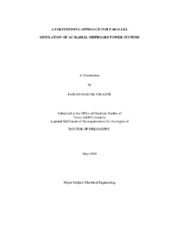| dc.description.abstract | An approach to parallelize the simulation of AC-Radial Shipboard Power Systems
(SPSs) using multicore computers is presented. Time domain simulations of SPSs are
notoriously slow, due principally to the number of components, and the time-variance of
the component models. A common approach to reduce the simulation run-time of power
systems is to formulate the electrical network equations using modified nodal analysis,
use Bergeron's travelling-wave transmission line model to create subsystems, and to
parallelize the simulation using a distributed computer. In this work, an SPS was
formulated using loop analysis, defining the subsystems using a diakoptics-based
approach, and the simulation parallelized using a multicore computer.
A program was developed in C# to conduct multithreaded parallel-sequential
simulations of an SPS. The program first represents an SPS as a graph, and then
partitions the graph. Each graph partition represents a SPS subsystem and is
computationally balanced using iterative refinement heuristics. Once balanced
subsystems are obtained, each SPS subsystem's electrical network equations are formulated using loop analysis. Each SPS subsystem is solved using a unique thread,
and each thread is manually assigned to a core of a multicore computer.
To validate the partitioning approach, performance metrics were created to assess
the speed gain and accuracy of the partitioned SPS simulations. The simulation
parameters swept for the performance metrics were the number of partitions, the number
of cores used, and the time step increment. The results of the performance metrics
showed adequate speed gains with negligible error.
An increasing simulation speed gain was observed when the number of partitions
and cores were augmented, obtaining maximum speed gains of <30x when using a quadcore
computer. Results show that the speed gain is more sensitive to the number
partitions than is to the number of cores. While multicore computers are suitable for
parallel-sequential SPS simulations, increasing the number of cores does not contribute
to the gain in speed as much as does partitioning.
The simulation error increased with the simulation time step but did not influence
the partitioned simulation results. The number of operations caused by protective
devices was used to determine whether the simulation error introduced by partitioning
SPS simulations produced a inconsistent system behavior. It is shown, for the time step
sizes uses, that protective devices did not operate inadvertently, which indicates that the
errors did not alter RMS measurement and, hence, were non-influential. | en |


